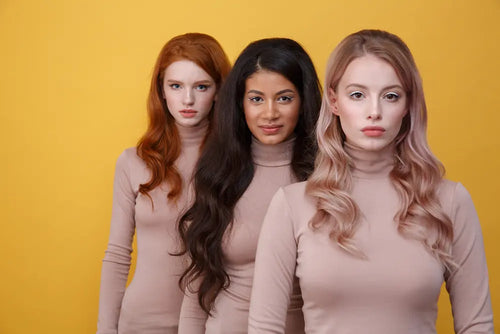Table of Contents
- Introduction: What is the Curly Girl Method?
- Chapter 1: The Golden Rules of the CGM Routine
- Chapter 2: Decoding Ingredients: What to Avoid and Why
- Chapter 3: How to Choose the Best Curly Girl Method Products
- Chapter 4: Common CGM Challenges and How to Fix Them
- Conclusion: Embrace Your Natural Texture
Introduction: What is the Curly Girl Method?
If you’ve ever looked in the mirror and wondered why your curls seem more frizz than definition, you are not alone. Many people with naturally curly or wavy hair know the frustration of battling dryness, undefined texture, and endless product experiments that never quite deliver.
That universal struggle inspired the Curly Girl Method—commonly called CGM—a routine that has transformed hair care for millions.
The Curly Girl Method was introduced by Lorraine Massey in her book Curly Girl: The Handbook. But it’s more than a routine. It’s a philosophy of embracing your natural texture by treating curls gently and feeding them the moisture they crave.
At its core, the method eliminates ingredients that dehydrate or suffocate curls, focusing instead on nourishing practices that allow natural curl patterns to thrive.
The foundation of CGM is simple: avoid sulfates, silicones, and drying alcohols. When removed from your routine, curls become softer, shinier, and easier to style. This approach has helped countless people achieve healthier, bouncier ringlets—and it might just transform your routine too.
Chapter 1: The Golden Rules of the CGM Routine
How to Do the Curly Girl Method: The Essential Steps
Getting started with CGM hair care means shifting away from traditional shampoo-and-style habits. Instead, you’ll focus on gentle cleansing, deep conditioning, and styling techniques that lock in hydration.
1. Reset Wash
Before beginning CGM, start with one final sulfate shampoo wash. This removes any silicone buildup left from conventional products. After this reset wash, sulfates are avoided entirely.
2. Co-Washing (Conditioner Washing)
Rather than shampooing daily, most people following CGM wash with conditioner. Co-washing helps maintain moisture while gently cleansing the scalp. The right conditioner leaves curls soft and hydrated without stripping natural oils.
3. Conditioning and the S2C Technique
Conditioning is the heart of CGM. Apply conditioner generously, then use the “squish to condish” technique—pressing water and conditioner into the hair to maximize absorption. This technique creates better curl clumping and long-lasting hydration.
4. Styling on Wet Hair
Curls love water. To define them, apply leave-in conditioner, curl cream, or gel on sopping wet strands. Products glide through evenly when hair is fully hydrated, ensuring consistent curl formation.
5. Gentle Drying
Say goodbye to terry cloth towels, which rough up the cuticle and cause frizz. Instead, blot curls with a microfiber towel or a cotton t-shirt. Skip the blow-dryer or only use it with a diffuser on a low-heat, low-speed setting. Protecting your curl pattern during drying is just as important as the products you apply.
By committing to these steps, achieving healthy CGM hair becomes less about luck and more about technique.
Chapter 2: Decoding Ingredients: What to Avoid and Why
CGM-Approved Ingredients: Your Product Checklist
One of the most empowering parts of the Curly Girl Method is learning to decode product labels. Instead of chasing marketing claims, you’ll know exactly what ingredients your curls need—and which ones to avoid.
Sulfates
These harsh detergents are found in many shampoos. While they cleanse effectively, they also strip natural oils that curls desperately need, leaving hair dry, frizzy, and prone to breakage.
Silicones
Often marketed as shine boosters, silicones coat the hair with a film that temporarily smooths frizz. But they create buildup that blocks moisture from entering the hair shaft. To remove them, sulfates are needed, which traps you in a damaging cycle.
Drying Alcohols
Not all alcohols are bad, but short-chain alcohols like isopropyl or ethanol evaporate quickly, pulling moisture out of the hair. Over time, they leave curls brittle. Fatty alcohols such as cetyl or cetearyl alcohol, on the other hand, are CGM-approved because they soften and condition.
Harsh Physical Exfoliants
Some scrubs contain crushed walnut shells or similar abrasives. These can scratch the scalp and damage the hair shaft—something curly hair, which is naturally delicate, cannot afford.
Avoiding these culprits not only prevents damage but also paves the way for better hydration, which is why the choice of curly girl method products matters so much.
Chapter 3: How to Choose the Best Curly Girl Method Products for Your Hair
Finding Your Holy Grail: A Guide to Curly Girl Method Products
Choosing the right CGM-approved products is less about copying someone else’s routine and more about understanding your own hair. Curl type and porosity both play major roles.
Porosity Basics
Porosity is your hair's ability to absorb and hold onto moisture. Low-porosity hair has a tightly bound cuticle layer, making it resistant to hydration but prone to buildup. High-porosity hair, often from damage or genetics, soaks up moisture quickly but loses it just as fast. Knowing your porosity helps you pick products that balance these tendencies.
Product Categories to Build Your Routine
Low-Poo Shampoos: Gentle cleansers without sulfates. Ideal for occasional deeper cleansing without stripping curls. Popular options include Giovanni Tea Tree Triple Treat and SheaMoisture Curl & Shine Shampoo.
Co-Washes: The everyday cleanser of CGM. Look for lightweight, silicone-free conditioners like As I Am Coconut CoWash or Eden BodyWorks Cleansing Conditioner.
Rinse-Out Conditioners: Essential for detangling and restoring softness. Try options like Not Your Mother’s Curl Talk Conditioner or Camille Rose Moroccan Pear Conditioning Custard.
Leave-In Conditioners: A must for long-lasting hydration. Kinky Curly Knot Today and Ouidad Moisture Lock Leave-In are fan favorites.
Curl Creams and Butters: These products define curls and reduce frizz. Ecoslay’s Orange Marmalade and SheaMoisture Curl Enhancing Smoothie are cult classics.
Gels and Mousses: To hold curl definition and control frizz, gels create a “cast” that is later scrunched out for soft curls. Popular picks include LA Looks Sport Gel (surprisingly CGM-approved) and Uncle Funky’s Daughter Curly Magic.
Always double-check labels since formulas change over time. Reading ingredients ensures that what you’re buying today is still CGM-friendly tomorrow.

Chapter 4: Common CGM Challenges and How to Fix Them
Troubleshooting Your CGM Journey
Feeling overwhelmed by the Curly Girl Method? That's completely normal! Many people experience the same initial bumps. Let's break down the typical struggles and how to fix them.
Product Buildup
Even with CGM products, buildup can happen, especially on low-porosity hair. Signs include limp curls or a waxy feel. A gentle low-poo wash once or twice a month often solves this issue.
Wet Frizz
If hair looks frizzy even when wet, it often means products aren’t applied with enough water. Reapply your conditioner or gel with soaking wet hair to improve clumping and definition.
Dryness
Deep conditioning treatments are a lifesaver. Use them weekly or biweekly to restore elasticity and shine. Adding steam or heat during treatments can boost absorption.
The Transition Period
Many newcomers experience an awkward phase where hair looks worse before it gets better. This happens as your hair adjusts to the absence of silicones and sulfates. Stay consistent—most people see improvement within a few weeks.
Weighed-Down Hair (Low Porosity Struggles)
If your curls feel heavy or greasy, you may be using products that are too rich. Switch to lighter leave-ins and gels, and avoid layering too many butters or creams.
Conclusion: Embrace Your Natural Texture
The Curly Girl Method is more than a set of rules—it’s a journey of learning what your curls need and how to nurture them. Success comes from patience, ingredient awareness, and consistent technique. The goal is not perfect curls but healthier, happier hair that reflects your natural beauty.
Experiment, take notes, and adapt your routine until you find what works best for your unique CGM hair. Every curl pattern tells its own story, and embracing it is a form of self-expression.
Ready to begin? Start small, stay curious, and celebrate every step of progress. Share your CGM journey in the comments—we’d love to hear how the method transforms your curls.



